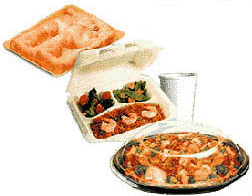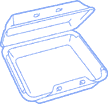|
What are the benefits of polystyrene foam?

Polystyrene foam is superior to other packaging materials because it is:
-
Cleaner.
-
Resists bacterial growth.
-
More visually appealing to
customers.
-
Easier to handle.

-
Moisture resistant.
-
Less expensive.
-
Lighter weight.
-
Valued for insulation qualities.
-
Environmentally sound.
-
Recyclable.
-
Automatable.
Polystyrene Facts
What keeps your hands cool and your coffee hot?
What helps keep food fresher longer?
What is lightweight yet strong?
Overview
Polystyrene is
found in your home, office, local grocery and in the cafeteria. It comes in many
shapes and forms, from foam egg cartons and meat trays, to soup bowls and salad
boxes, from coffee cups and utensils to CD "jewel boxes," and from produce trays
to "peanuts" used in packing and the lightweight foam pieces that cushion new
appliances and electronics.
Polystyrene Gets the Job Done!
-
It guards against leaking and keeps its shape
when holding your take-out meal.
-
It keeps hot food hot and cold food cold,
while you hold the package in comfort.
package in comfort.
-
It cradles your fruit, vegetables, eggs and
meat to keep them fresh and intact.
-
It is an excellent low-cost and sanitary
choice for food service packaging.
-
It protects valuable shipments without adding
significant weight.
-
Nothing else offers the combination of
strength, lightness and durability to protect valuable objects from crystal to
computers, from morning coffee to salad at lunch, from your children to you!
Back
to the Top

Sanitary
Tests have shown that disposable food service
ware (such as polystyrene cups, plates and utensils) is more sanitary than
reusable service ware. Health officials, who regulate food service operations in
schools, hospitals and restaurants, recognize this important product benefit. In
fact, national environmental health officials passed a resolution stating that
restricting the use of disposable cups, plates and containers would have a
potentially adverse impact on disease prevention.
Sturdy
Polystyrene protects against moisture and
maintains its strength and shape even after long periods of time. Containers and
lids close tightly, guarding against leaks while maintaining an ideal
temperature. Additionally, polystyrene foam egg cartons and meat trays perform
extremely well in automated processing equipment.
Polystyrene packaging offers exceptional
protection. Its shape can be molded (custom fit) to parts and products,
maximizing its excellent cushioning characteristics.
Efficient
Only about five percent of a foam package is
polystyrene, the rest is air! Polystyrene provides the superior insulating
quality that helps hold food at the optimal eating or drinking temperature
longer than many alternatives. This helps to guard against waste. Polystyrene
maintains hot food at temperatures required by many health departments, yet
remains comfortable to hold.
Economical
Polystyrene food service products are generally
more economical to use than disposable paperboard products and reusable food
service items. The wholesale price of polystyrene disposable food service
products is often approximately two to three times less than an equivalent
disposable paper container, and four to five times less than a comparable
reusable food service item when the costs of equipment, labor, water,
electricity, and detergent costs are included. This allows schools, hospitals
and other institutions to make better use of their limited budgets. Its light
weight helps reduce shipping costs. Its cushioning ability reduces breakage,
resulting in fewer damaged goods.
Convenient
Today's busy lifestyles require the convenience
of affordable and quick take-out meals. Polystyrene packaging meets the demands
of today's modern lifestyles by offering an economical and high quality food
service product

#1
Polystyrene may be best known for its foam coffee
cups, but most polystyrene is used to make rigid durable products, such as
television and computer cabinets, appliances, toys, compact disc "jewel cases"
and audiocassette cases.
#2
All polystyrene packaging comprises only a tiny
fraction of the material that goes into our landfills. In fact, less than one
percent by weight of the total municipal solid waste disposed is polystyrene.
Paper and paperboard products make up the largest category of material (about 31
percent) disposed in our landfills.
#3 No chlorofluorocarbons (CFCs) are used in the
manufacture of any polystyrene foam packaging products in Malaysia and
have not been since 1990. In fact, all polystyrene foam products never were
made with CFCs.
#4
The thermal insulating ability of polystyrene
foam contributes to the success of programs such as "Meals on Wheels," which
serve millions of senior citizens.
#5 Very little of the waste discarded in today's
modern, highly engineered landfills biodegrades. Because degradation of
materials creates potentially harmful liquid and gaseous by-products that could
contaminate groundwater and air, today's landfills are designed to minimize
contact with air and water required for degradation, thereby practically
eliminating the degradation of waste.
#6 The manufacture of all polystyrene,
to make both durable and packaging products, uses a fraction of one percent of
the nation's natural gas and petroleum.

...polystyrene packaging comes in two forms:
foam and solid?
The most recognizable forms of polystyrene
packaging are
 expanded and extruded foams. Foamed polystyrene is used to make
cups, bowls, plates, trays, clamshell containers, meat trays and egg cartons as
well as protective packaging for shipping electronics and other fragile items. expanded and extruded foams. Foamed polystyrene is used to make
cups, bowls, plates, trays, clamshell containers, meat trays and egg cartons as
well as protective packaging for shipping electronics and other fragile items.

Solid polystyrene is used in products such as
cutlery, yogurt and cottage cheese containers, cups, clear salad bar containers
and video and audiocassette housings.
...many businesses and institutions depend on
polystyrene packaging?
Schools, hospitals, nursing homes, supermarkets,
restaurants and sports stadiums are among the many institutions and businesses
that rely on polystyrene packaging. Its sturdy construction and sanitary design
provide excellent insulation at an economical cost. Grocery stores use
polystyrene in virtually all meat and poultry trays. In addition, polystyrene
packaging can be found in egg cartons and a variety of produce packages, such as
apple trays, mushroom tills, tomato containers, and strawberry and grape crates.
...polystyrene makes exceptional protective
packaging?
Polystyrene protective packaging comes in two
primary forms loose fill "peanuts" and shape molded packaging. Loose fill
"peanuts" allow variously shaped items, such as office supplies or cosmetics, to
be shipped in the same box. Shape molded packaging fits snugly around delicate
products like computers, television sets, stereo equipment and appliances to
protect them during shipping.
Both shape
molding and loose fill are lighter in weight than other protective packaging,
saving energy and money during shipment. They also resist moisture and do not
attract rodents or insects. An added benefit, polystyrene protective packaging
can be used over and over again through reuse and recycling.
...Good for Families, Safe for the Environment. Wherever you live, wherever you work, chemicals
are a vital part of your life. They are a key component in the products you use
to clean your skin, in the building materials you use for the construction of
your home and in the packaging products you use for your food.
For example, did you know the shampoo we use to
make our hair feel so clean contains hydroxypropyl methylcellulose - and the
"natural" barley and wheat cereal that makes us feel so healthy is made with
thiamin mononitrate? With these wordy terms in mind, it is not hard to
understand why people get confused when polystyrene manufacturers attempt to
explain the nature of their products.
This fact sheet should help you gain a deeper understanding of why
polystyrene is the best choice for food service packaging.
A LOOK
INSIDE
What is Inside?
Styrene, a petroleum by-product, is the primary
raw material from which polystyrene is made. Styrene, first commercially
produced in the 1930s, played an important role during World War II in the
production of synthetic rubber. After the war, much of the use of styrene
shifted to the manufacture of commercial polystyrene products. Synthetic styrene
is also used in the manufacture of products such as automobile parts, electronic
components, boats, recreational vehicles, and synthetic rubbers. Today, you or a
member of your family will probably use a product derived from styrene.
Modern man has known about styrene for centuries.
A naturally occurring substance, styrene is present in many foods and beverages,
including wheat, beef, strawberries, peanuts and coffee beans. Also found in the
spice cinnamon, its chemical structure is similar to cinnamic aldehyde, the
chemical component that elicits cinnamon's flavor.
Polystyrene meets stringent U.S. FDA standards for use in food contact packaging
and is safe for consumers. Health organizations encourage the use of single-use
food service products, including polystyrene, because they provide increased
food safety.
All packaging (glass, aluminum, paper, and
plastic - including polystyrene) contains substances that can "migrate," or
transfer, to foods or beverages. The FDA regulates residual levels of these
components in food packaging to ensure that packaging is safe to use.
What is Not Inside?
Polystyrene foam products are 95 percent air and
only five percent polystyrene. When polystyrene foam packaging is produced, a
blowing agent is used in the process. Most polystyrene foam products never were
made using chlorofluorocarbons (CFCs) as a blowing agent.
Polystyrene foam products are now manufactured
primarily using two types of blowing agents: Pentane and Carbon Dioxide.
Pentane gas has no effect on the upper ozone
layer, although, if not recovered, it can contribute to low-level smog
formation. Therefore, manufacturers use state-of-the-art technology to capture
pentane emissions.
With ever-evolving technology, some manufacturers
use carbon dioxide (CO2 or other hydrocarbons in some cases) as an expansion
agent for polystyrene foam. CO2 is non-toxic, non-flammable, does not contribute
to low-level smog, and has no stratospheric ozone depletion potential. In
addition, the carbon dioxide used for this technology is recovered from existing
commercial and natural sources. As a result, the use of this blowing agent
technology does not increase the levels of CO2 in the atmosphere. |



